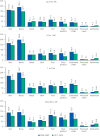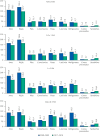Most consumed foods in Brazil: evolution between 2008-2009 and 2017-2018
- PMID: 34852162
- PMCID: PMC8659613
- DOI: 10.11606/s1518-8787.2021055003406
Most consumed foods in Brazil: evolution between 2008-2009 and 2017-2018
Abstract
Objective: To describe the evolution of food consumption by the Brazilian population in 2008-2009 to 2017-2018.
Methods: Data from the National Dietary Surveys of 2008-2009 and 2017-2018 were used. Both surveys estimated food consumption of two non-consecutive days of individuals aged 10 years or older. The first survey collected consumption data from 34,003 individuals through food records; the second, obtained data from 46,164 individuals, through 24-hour recalls. The twenty most frequently reported food groups in the two surveys were identified. The probability of consumption of each food group in the two surveys was estimated according to sex, age and income. This study presents the foods that had a change in the frequency of consumption of 5% or higher between the two surveys. The probability of consumption was corrected for intra-individual variability using the method developed by the National Cancer Institute.
Results: Rice, beans, coffee, bread, vegetables and beef remained the staple Brazilian diet, ranking as the six most consumed items in both surveys. Ultra-processed foods such as sweet/stuffed cookies, savory cookies, processed meats and carbonated drinks also remained among the 20 most consumed foods. Trend analyses showed, regardless of gender, age and income range, a decrease in the consumption of rice, beans, beef, bread, fruit, milk and dairy, processed meats and carbonated drinks, and an increase in the consumption of sandwiches.
Conclusion: The Brazilian diet is still characterized by consumption of traditional foods, such as rice and beans, and by high frequency of consumption of ultra-processed foods, such as cookies and carbonated drinks. However, between the years of 2008-2009 and 20172018, there was a decrease in the consumption of rice, beans, beef, bread, fruit, milk and dairy, processed meats and carbonated drinks, but an increase in the consumption of sandwiches. The results show a decrease in quality in the Brazilian diet.
OBJETIVO:: Descrever a evolução do consumo alimentar da população brasileira de 2008–2009 a 2017–2018.
MÉTODOS:: Foram utilizados dados dos Inquéritos Nacionais de Alimentação de 2008–2009 e 2017–2018, que estimaram o consumo alimentar de dois dias não consecutivos de indivíduos com 10 anos ou mais de idade. O primeiro inquérito colheu dados de consumo de 34.003 indivíduos por meio de registro alimentar; o segundo, de 46.164 indivíduos, por meio de recordatório de 24 horas. Identificaram-se os 20 grupos de alimentos mais frequentemente referidos nos dois inquéritos. A probabilidade de consumo de cada um dos grupos de alimentos nos dois inquéritos foi estimada segundo sexo, idade e renda. No presente estudo, são apresentados os alimentos que tiveram mudança igual ou superior a 5% na frequência de consumo entre os dois inquéritos. A probabilidade de consumo foi corrigida para a variabilidade intraindividual, utilizando método desenvolvido pelo National Cancer Institute.
RESULTADOS:: Arroz, feijão, café, pães, hortaliças e carne bovina permaneceram como base da alimentação dos brasileiros, sendo os seis itens mais consumidos em ambos os inquéritos. Alimentos ultraprocessados, como biscoitos doces/recheados, biscoitos salgados, carnes processadas e refrigerantes, também se mantiveram entre os 20 alimentos mais consumidos. As análises de tendência evidenciaram, independentemente de sexo, idade e faixa de renda, a diminuição do consumo de arroz, feijão, carne bovina, pães, frutas, laticínios, carnes processadas e refrigerantes, e o aumento da ingestão de sanduíches.
CONCLUSÃO:: A dieta do brasileiro permanece caracterizada pelo consumo de alimentos tradicionais, como arroz e feijão, e pela frequência elevada de ingestão de alimentos ultraprocessados, como biscoitos e refrigerantes. No entanto, entre os anos de 2008–2009 e 2017–2018, observou-se redução no consumo de arroz, feijão, carne bovina, pães, frutas, laticínios, carnes processadas e refrigerantes, mas aumento no consumo de sanduíches. Os resultados sinalizam piora na qualidade da alimentação do brasileiro.
Conflict of interest statement
Figures




Similar articles
-
Most consumed foods in Brazil: National Dietary Survey 2008-2009.Rev Saude Publica. 2013 Feb;47 Suppl 1:190S-9S. doi: 10.1590/s0034-89102013000700005. Rev Saude Publica. 2013. PMID: 23703263 English, Portuguese.
-
Consumption of vegetables and their relation with ultra-processed foods in Brazil.Rev Saude Publica. 2018;52:50. doi: 10.11606/s1518-8787.2018052000111. Epub 2018 May 21. Rev Saude Publica. 2018. PMID: 29791530 Free PMC article.
-
Adult food consumption by household composition: an analysis of the first National Dietary Survey, Brazil, 2008-2009.Public Health Nutr. 2020 Feb;23(2):193-201. doi: 10.1017/S1368980019002374. Epub 2019 Sep 2. Public Health Nutr. 2020. PMID: 31475661 Free PMC article.
-
Public Health Response to the SARS-CoV-2 Pandemic: Concern about Ultra-Processed Food Consumption.Foods. 2022 Mar 25;11(7):950. doi: 10.3390/foods11070950. Foods. 2022. PMID: 35407037 Free PMC article. Review.
-
Development and Evaluation of the Dietary Pattern Calculator (DiPaC) for Personalized Assessment and Feedback.Can J Diet Pract Res. 2024 Mar 1;85(1):25-31. doi: 10.3148/cjdpr-2023-013. Epub 2023 Oct 12. Can J Diet Pract Res. 2024. PMID: 37824093 Review.
Cited by
-
Factors associated with the dietary patterns of Brazilian adolescents: analysis of the National Survey of School Health.J Pediatr (Rio J). 2025 Mar-Apr;101(2):247-254. doi: 10.1016/j.jped.2024.09.006. Epub 2024 Nov 8. J Pediatr (Rio J). 2025. PMID: 39522557 Free PMC article.
-
Consumers' Understanding of Ultra-Processed Foods.Foods. 2022 May 7;11(9):1359. doi: 10.3390/foods11091359. Foods. 2022. PMID: 35564081 Free PMC article.
-
Workers' healthy eating practices during the COVID-19 pandemic and their relationship with physical activity and quality of life.J Nutr Sci. 2024 Sep 25;13:e48. doi: 10.1017/jns.2024.45. eCollection 2024. J Nutr Sci. 2024. PMID: 39345248 Free PMC article.
-
Food consumption markers and sociodemographic factors associated with obesity among adult women registered in the Food and Nutrition Monitoring System (SISVAN) in Brazil: a cohort study, 2015-2019.Front Public Health. 2024 Oct 22;12:1467339. doi: 10.3389/fpubh.2024.1467339. eCollection 2024. Front Public Health. 2024. PMID: 39502815 Free PMC article.
-
The global diet quality score as an indicator of adequate nutrient intake and dietary quality - a nation-wide representative study.Nutr J. 2024 Apr 17;23(1):42. doi: 10.1186/s12937-024-00949-x. Nutr J. 2024. PMID: 38627669 Free PMC article.
References
-
- Shan Z, Rehm CD, Rogers G, Ruan M, Wang DD, Hu FB, et al. Trends in dietary carbohydrate, protein, and fat intake and diet quality among US adults, 1999-2016. JAMA. 2019;322(12):1178-87. https://doi.org/10.1001/jama.2019.13771 - PMC - PubMed
-
- Instituto Brasileiro de Geografia e Estatística, Diretoria de Pesquisas, Coordenação de Trabalho e Rendimento. Pesquisa de Orçamentos Familiares 2017-2018: avaliação nutricional da disponibilidade domiciliar de alimentos no Brasil. Rio de Janeiro: IBGE, 2020.
-
- Canhada SL, Luft VC, Giatti L, Duncan BB, Chor D, Fonseca MJM, et al. Ultra-processed foods, incident overweight and obesity, and longitudinal changes in weight and waist circumference: The Brazilian Longitudinal Study of Adult Health (ELSA-Brasil). Public Health Nutr. 2020;23(6):1076-86. https://doi.org/10.1017/S1368980019002854 - PMC - PubMed
-
- Srour B, Fezeu LK, Kesse-Guyot E, Allès B, Debras C, Druesne-Pecollo N, et al. Ultraprocessed food consumption and risk of type 2 diabetes among participants of the NutriNet-Santé Prospective Cohort. JAMA Intern Med. 2020;180(2):283-91. https://doi.org/10.1001/jamainternmed.2019.5942 - PMC - PubMed
-
- Instituto Brasileiro de Geografia e Estatística, Diretoria de Pesquisas, Coordenação de Trabalho e Rendimento. Pesquisa de Orçamentos Familiares 2017-2018: análise da segurança alimentar no Brasil. Rio de Janeiro: IBGE, 2020.
MeSH terms
LinkOut - more resources
Full Text Sources

